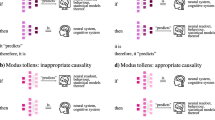Abstract
Traditional approaches to cognitive psychology are founded on a classical vision of logic and probability theory. According to this perspective, the probabilistic aspects of human reasoning can be formalized in a Kolmogorovian probability framework and reveal underlying Boolean-type logical structures. This vision has been seriously challenged by various discoveries in experimental psychology in the last three decades. Meanwhile, growing research indicates that quantum theory provides the conceptual and mathematical framework to deal with these classically problematical situations. In this paper, we apply a general quantum-based modeling scheme to represent two types of cognitive situations where deviations from classical probability occur in human decisions, namely, ‘conceptual categorization’ and ‘decision making’. We show that our quantum-theoretic modeling faithfully describes different sets of experimental data, explaining the observed deviations from classicality in terms of genuine quantum effects. These results may contribute to the development of applied disciplines where cognitive processes are involved, such as natural language processing, semantic analysis, and information retrieval.
Similar content being viewed by others
Notes
It is worth to mention that our quantum conceptual approach shares some common aspects with the ‘epistemic quantum computational structures’ recently developed by some authors (see, e.g., Dalla Chiara et al. 2015), where emergent conceptual properties are formalized, and an holistic meaning of the sentence is considered instead of a compositional one. Notwithstanding their similarities, the technical developments of the two approaches are different.
The disjunction fallacy introduced here must be distinguished from the disjunction effect discussed in Sect. 4. The latter is classified as a ‘decision making error’, the former as a ‘probability judgement error’. Notwithstanding their conceptual differences, however, both effects can be described in terms of quantum interference effects (see also Busemeyer and Bruza 2012).
References
Aerts D (1986) A possible explanation for the probabilities of quantum mechanics. J Math Phys 27:202–210
Aerts D (2009) Quantum structure in cognition. J Math Psychol 53:314–348
Aerts D, Aerts S (1995) Applications of quantum statistics in psychological studies of decision processes. Found Sci 1:85–97
Aerts D, Aerts S, Broekaert J, Gabora L (2000) The violation of Bell inequalities in the macroworld. Found Phys 30:1387–1414
Aerts D, Broekaert J, Gabora L, Sozzo S (2013) Quantum structure and human thought. Behav Brain Sci 36:274–276
Aerts D, Broekaert J, Smets S (1999) A quantum structure description of the liar paradox. Int J Theor Phys 38:3231–3239
Aerts D, Broekaert J, Sozzo S, Veloz T (2014) Meaning-focused and quantum-inspired information retrieval. Lect Notes Comput Sci 8369:71–83
Aerts D, Gabora L (2005a) A theory of concepts and their combinations I: the structure of the sets of contexts and properties. Kybernetes 34:167–191
Aerts D, Gabora L (2005b) A theory of concepts and their combinations II: a Hilbert space representation. Kybernetes 34:192–221
Aerts D, Gabora L, Sozzo S (2013) Concepts and their dynamics: a quantum-theoretic modeling of human thought. Top Cogn Sci 5:737–772
Aerts D, Sozzo S (2011) Quantum structure in cognition. Why and how concepts are entangled. Lect Notes Comput Sci 7052:116–127
Aerts D, Sozzo S (2014) Quantum entanglement in conceptual combinations. Int J Theor Phys 53:3587–3603
Aerts D, Sozzo S, Tapia J (2014) Identifying quantum structures in the Ellsberg paradox. Int J Theor Phys 53:3666–3682
Aerts D, Sozzo S, Veloz T (2015) Quantum structure in cognition and the foundations of human reasoning. Int J Theor Phys. doi:10.1007/s10773-015-2717-9 (online)
Busemeyer JR, Bruza PD (2012) Quantum models of cognition and decision. Cambridge University Press, Cambridge
Chiara Dalla ML, Giuntini R, Negri E (2015) A quantum approach to vagueness and to the semantics of music. Int J Theor Phys. doi:10.1007/s10773-015-2694-z (online)
Dirac PAM (1958) Quantum mechanics, 4th edn. Oxford University Press, Oxford
Ellsberg D (1961) Risk, ambiguity, and the Savage axioms. Quart J Econ 75:643–669
Hampton JA (1988a) Overextension of conjunctive concepts: Evidence for a unitary model for concept typicality and class inclusion. J Exp Psychol Learn Mem Cogn 14:12–32
Hampton JA (1988b) Disjunction of natural concepts. Mem Cogn 16:579–591
Haven E, Khrennikov AY (2013) Quantum social science. Cambridge University Press, Cambridge
Khrennikov AY (2010) Ubiquitous quantum structure. Springer, Berlin
Machina MJ (2009) Risk, ambiguity, and the dark dependence axioms. Am Econ Rev 99:385–392
Morier DM, Borgida E (1984) The conjuction fallacy: a task specific phenomena? Pers Soc Psychol Bull 10:243–252
Osherson D, Smith E (1981) On the adequacy of prototype theory as a theory of concepts. Cognition 9:35–58
Pitowsky, I.: Quantum Probability, Quantum Logic. Lecture Notes in Physics, vol. 321. Berlin: Springer, Berlin (1989)
Rosch E (1973) Natural categories. Cogn Psychol 4:328–350
Savage LJ (1954) The foundations of statistics. Wiley, New York
Sozzo S (2014) A quantum probability explanation in Fock space for borderline contradictions. J Math Psychol 58:1–12
Sozzo S (2015) Conjunction and negation of natural concepts: a quantum-theoretic modeling. J Math Psychol 66:83–102
Tversky A, Kahneman D (1983) Extension versus intuitive reasoning: The conjunction fallacy in probability judgment. Psychol Rev 90:293–315
Tversky A, Shafir E (1992) The disjunction effect in choice under uncertainty. Psychol. Sci. 3:305–309
Author information
Authors and Affiliations
Corresponding author
Additional information
Communicated by M. L. Dalla Chiara, R. Giuntini, E. Negri and S. Smets.
Rights and permissions
About this article
Cite this article
Sozzo, S. Effectiveness of the quantum-mechanical formalism in cognitive modeling. Soft Comput 21, 1455–1465 (2017). https://doi.org/10.1007/s00500-015-1834-y
Published:
Issue Date:
DOI: https://doi.org/10.1007/s00500-015-1834-y




